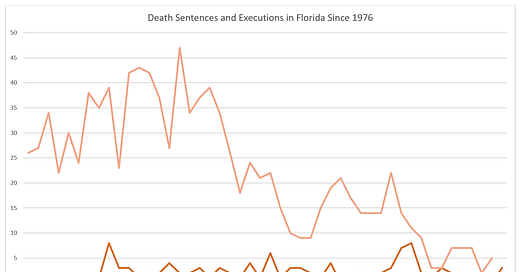Florida's death penalty since 1976
This post includes a chart illustrating the number of death sentences imposed and executions completed since 1976.
In 1972, in Furman v. Georgia, the U.S. Supreme Court held that the way death sentences were imposed across the country violated the Eighth Amendment to the U.S. Constitution. Furman ushered in modern capital sentencing.
After Gregg v. Georgia in 1979, states had to revamp their capital sentencing schemes in order to maintain capital punishment. The sentencing schemes had to include individualized consideration of the defendant and the crime to satisfy the Eighth Amendment, as interpreted in Furman.
Florida was the first state to reinstitute capital punishment after Gregg. Since then, it has remained a national leader in capital punishment. In 1979, it was the “first state to carry out a non-voluntary execution” after Gregg with the execution of John Spenkelink, the first post-Furman execution in the State.1
The chart below illustrates the number of new death sentences and executions each year since Florida reinstated capital punishment in 1976.
The highest number of death sentences imposed in one year is 47, which was in 1991. Under Hurst v. Florida,2 the way Florida imposed sentences of death until 2017 violated capital defendants’ right to jury trial under the Sixth Amendment to the U.S. Constitution.
The highest number of executions completed in one year is 8, which was the number of executions in both 1984 (Gov. Bob Graham) and 2014 (Gov. Rick Scott).
*For 2023, the number of executions used is three. A fourth execution is currently scheduled for June 15, 2023. In the chart above, there is no value for death sentences in 2023.
**For 2022, there is a discrepancy in the data from the Death Penalty Information Center (DPIC). Five is used in the graph, as stated here. However, another DPIC page says the number was four.
Sources
Execution List: 1976-Present, Fla. Dep’t of Corrs.
Death Row, Fla. Dep’t of Corrs.
The quote is from the Death Penalty Information Center.



